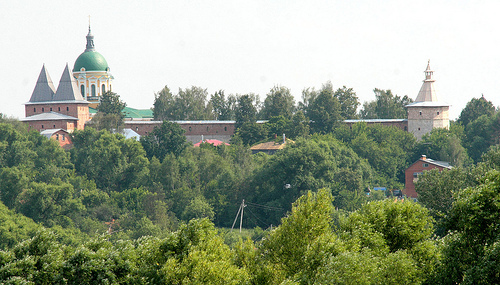

Location: Zaraysk
Constructed: 1528- 31
The Zaraysk Kremlin is a unique monument of 16th-century Russian fortification architecture, located in the town of Zaraysk in the Moscow Region, on the right bank of the Osetr River. It is considered the smallest of Russia's fully preserved kremlins and is listed as a federal cultural heritage site. The Kremlin combines elements of a fortress, a temple complex, and a museum, attracting tourists with its compact size and historical significance. Below, I will describe in detail its history, architecture, interior space, and modern significance.
In 1681 Zaraysk Castle receives a Cathedral of Saint Nicholas. The order for its construction is given by Tsar Fedor Alekseevich and its chief designers becomes Peter Liubavskii. It kept a miracle working icon of Saint Nicholas of Zaraisk that originally was moved here from Korsun in 1225. After the Soviet Revolution the church was looted by the atheist government. Today the icon is kept in a Museum of Old Russian Art in Moscow. The church contains iconostasis of XVIII century.
The Church of Saint John the Baptist was built in 1821. In 1904 the church got a facelift with addition of exterior decorations.
The stone Kremlin, built in 1528-1531,
covers an area of 134 × 190 m, rectangular in plan. The Kremlin
has 7 powerful towers, of which 3 are with gates. The fourth
(Trinity - in the eastern wall) gate was pierced in 1789.
Nikolsky Cathedral (1681).
John the Baptist Cathedral (1904).
The building of the Zaraisk theological school (1864).
The city of Zaraysk (formerly known as Krasny, Zaraysk-Ryazansky, and Novaya Zavod) was first mentioned in chronicles in 1146 as part of the Ryazan Principality. In the 16th century, during the strengthening of the defenses of the southern borders of the Muscovite state from the raids of the Crimean Tatars and the Golden Horde, Grand Duke Vasily III issued a decree ordering the construction of a stone fortress. Work continued from 1528 to 1531 under the supervision of Italian craftsmen (possibly Aleviz Fryazin or his students), which was typical of the time—many Russian fortresses were built with the participation of Italian engineers. Construction took only three years, and the Kremlin became one of the strongholds of the Great Abatis Line—a system of fortifications in southern Rus'. In the following centuries, the Kremlin withstood repeated sieges: in 1533, 1541, and 1570, it repelled raids by the Crimean Tatars, and during the Time of Troubles (1606–1613), it served as a base for the militia. In the 17th and 18th centuries, the fortress lost its military significance, but was used as an administrative center. In the 19th century, it housed a prison and warehouses, and in 1919, the Kremlin was transferred to a museum. During the Great Patriotic War, it suffered no significant damage, despite the city being occupied. Restoration work was carried out in the 1960s–1980s, returning the Kremlin to its historical appearance. Today, it is the Zaraysk Kremlin State Museum-Reserve, founded in 1918 from the collections of the Bakhrushin philanthropists.
The Zaraysk Kremlin is rectangular, with sides measuring 125 meters
(north-south) and 185 meters (east-west), making it the most compact of
all Russian kremlins. The perimeter of the walls is approximately 620
meters. The walls are constructed of white cut limestone (lower part)
and red brick (upper part), with a thickness of up to 3 meters and a
height of 8-9 meters. They are crowned with dovetail-shaped battlements
and have loopholes for firing cannons and rifles. The Kremlin is
surrounded by an earthen rampart and a moat (now partially filled in),
which strengthened its defenses.
The fortress has seven towers: four
corner (round) towers and three gate (rectangular) towers. The corner
towers—Taynitskaya (southwestern, with an underground passage to the
river), Kabatskaya (northwestern), Karaulnaya (northeastern), and
Spasskaya (southeastern)—are designed for all-round defense and have
tented roofs.
The gatehouse towers—Nikolskaya (western, main
gate), Yegoryevskaya (eastern), and Blagoveshchenskaya (northern)—are
equipped with oak gates and retractable iron portcullises. The
architecture combines Russian traditions with Italian influences:
massive forms, arcades, and decorative elements. The Kremlin is the only
one in the Moscow region that has been completely preserved without
significant reconstruction.
The Kremlin occupies 2.3 hectares and houses several historic
buildings. The central feature is the Nikolsky Cathedral (1681, rebuilt
in the 19th century), dedicated to St. Nicholas the Wonderworker. This
five-domed church features a green dome, frescoes, and an 18th-century
iconostasis. Nearby is the Cathedral of St. John the Baptist (1901–1904,
eclectic style), built with funds from the Bakhrushin brothers. It
features a green dome and a bell tower, and the interior is decorated
with mosaics and murals.
Other buildings include the government
building (18th century, now a museum exhibit), the Trinity Church
(destroyed in the 1930s, partially restored), and an archaeological
complex. The museum-reserve includes exhibits on the history of Zaraysk,
archaeology (the famous Zaraysk Paleolithic site), and art. Icons,
weapons, household items, and the collection of sculptor A.S. Golubkina
are housed here. The grounds are well-maintained, with lawns, paths, and
monuments (for example, to Prince Dmitry Pozharsky).
The Zaraysk Kremlin symbolizes the defense of Rus''s southern borders
and is a key cultural tourism destination in the Moscow region. It is
associated with heroes of the Time of Troubles, such as Prince Dmitry
Pozharsky, who rallied his militia here in 1611. As a museum, it is
visited by thousands of tourists annually, offering tours, festivals,
and educational programs.
Today, the Kremlin is open to visitors
daily (except Mondays); admission is charged (approximately 300 rubles
for adults). Address: Zaraysk, Kremlin Square. A visit during the warmer
months is recommended to explore the walls and towers. If you are
planning a trip, check the current schedule on the official website,
museumzaraysk.ru.